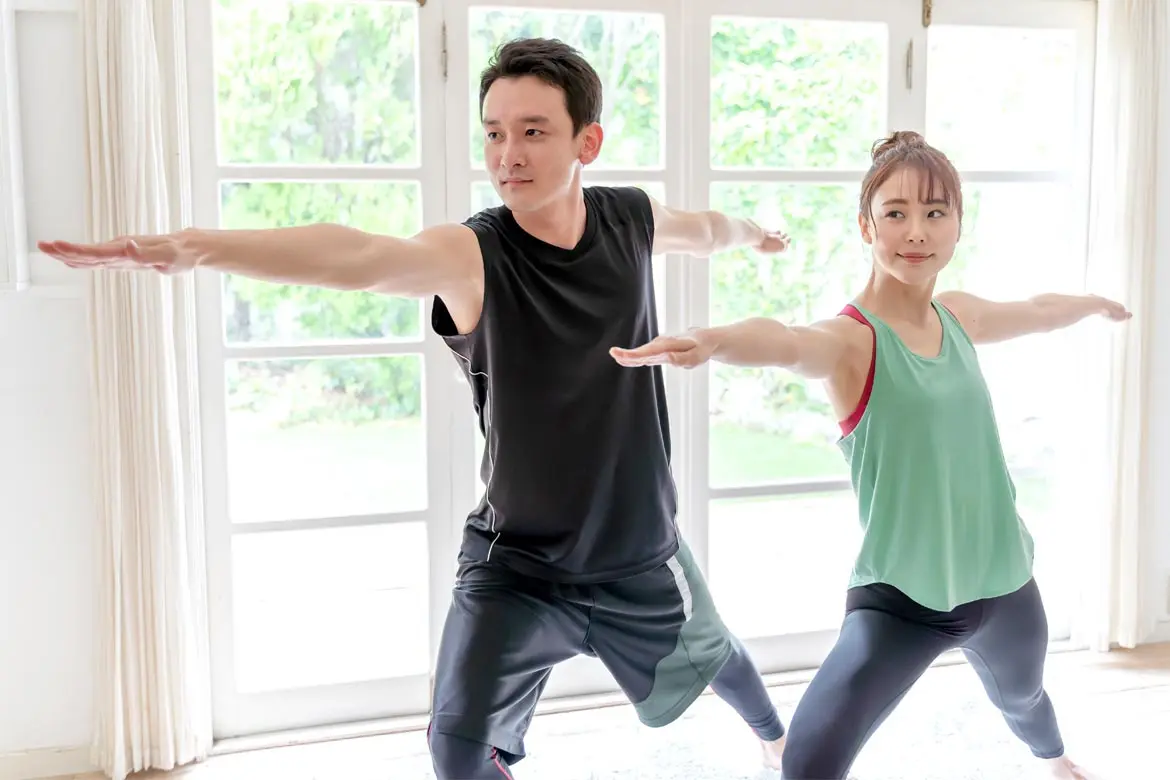-
-
Featured Care Areas


Source: Shutterstock
12 Easy Exercises to Do at Home: How-to Tips & Safety
Last updated: Monday, January 17, 2022 | 9 min reading time
Joanne Shaw, principal physiotherapist at Gleneagles Hospital shares tips on technique and safety in your home exercise routine.
12 easy exercises to do at home
In response to the country's increasing number of COVID-19 cases, Singapore has put in place several safety measures. Singaporeans are advised to stay at home and practise social distancing. Naturally, this means that gyms and public exercise facilities are closed and anyone who needs to exercise and get some fresh air do it alone. However, being stuck at home doesn't mean you can't exercise.
Here are 12 easy exercises you can do at home that are suitable for both beginners and experienced individuals. What's even better is that you can do all of them with little to no equipment.
Home Exercise 1: Basic Squats
Muscles targeted: Quadriceps, hamstrings, glutes
Potential risk for injury: When done incorrectly, squats can cause knee sprain, tendonitis, tendon or cartilage tears, and lower back pain.
Equipment needed: none
Recommended reps: 12 – 15
How to do it:
- Stand with your feet shoulder-width apart with your arms resting at your sides.
- Tighten your core for stabilisation, then with your chest thrust upward, start to shift your weight back into your heels while pushing your hips behind you as if you are sitting down on a chair.
- Once your thighs are parallel to the floor, pause. Then push up through your heels until you are back at your starting position.
Home Exercise 2: Lunges
Muscles targeted: Quadriceps, hamstrings, glutes, calves
Potential risk for injury: Stepping too far forward may cause muscle strains and/or ligament strain and tears. If you step too far back, you may put too much strain on your back knee.
Equipment needed: none
Recommended reps: 10 – 12 per leg
How to do it:
- Start by standing up straight.
- Step forward with one foot until your leg reaches a 90-degree angle. Make sure your rear knee remains parallel to the ground and your front knee doesn't extend beyond your toes.
- Lift your front lunging leg to return to the starting position, and then do the same with your other leg.
Home Exercise 3: Kneeling Push-ups
Muscles targeted: Pectoral muscles, shoulder muscles, biceps, triceps
Potential risk for injury: When done daily, push ups may cause wrist, back, and elbow pain.
Equipment needed: none
Recommended reps: Start with 10
How to do it:
- Start with your hands and knees on the ground, and your gaze looking towards the floor.
- Place your hands shoulder distance apart. Make sure your knees are a comfortable distance apart.
- Lower your elbows until to bring your chest toward the ground. Be sure to keep your core muscles contracted. Breathe in as you lower yourself down.
- Pause for a second in the lowered position and exhale as you push up from the ground back to your starting position.
Home Exercise 4: Kneeling Side Planks
Muscles targeted: Oblique abdominal muscles
Potential risk for injury: If you hold the side plank for longer than you're able to, you may get a strain injury.
Equipment needed: None
Recommended reps: Hold for 15 seconds
How to do it:
- Lie on one side with your knees bent. Prop yourself onto your elbow on the same side.
- Brace your core and raise your hips until your body forms a straight line from shoulder to knees.
- Hold this position for about 15 seconds (or as long as you can) while breathing deeply. Roll over and repeat on the other side.
Home Exercise 5: Sit-ups
Muscles targeted: Hip flexors, chest, neck, rectus abdominis, transverse abdominis, and obliques
Potential risk for injury: Doing too many sit-ups may cause abdominal muscle strain as well as lower back and neck injuries.
Equipment needed: None
Recommended reps: 10
How to do it:
- Lie down on your back. Bend your legs and plant your feet firmly on the ground to stabilise your lower body.
- Place your hands behind your ears without pulling your neck.
- Curl your upper body halfway up toward your knees and exhale as you do so.
- Slowly lower yourself to your starting point and inhale as you do so.
Home Exercise 6: Glute Bridges
Muscles targeted: Gluteus muscles, abdominal muscles, hamstrings
Potential risk for injury: Raising your hips too high may hyperextend your lower back and lead to strain.
Equipment needed: None
Recommended reps: 10
How to do it:
- Lie on your back with your hands at your sides, knees bent, and feet flat on the floor right under your knees.
- Tighten your abdominal and gluteus muscles by pushing your lower back into the ground before you push upwards.
- Raise your hips to form a straight line from knees to shoulders.
- Hold the position for 20 seconds before returning to your starting position.
Home Exercise 7: Dead Bug
Muscles targeted: Erector spinae, obliques, rectus abdominis, transverse abdominis
Potential risk for injury: If you don't pay attention to your form, you run the risk of injuring your lower back.
Equipment needed: none
Recommended reps: 5 – 12 per side
How to do it:
- Lie on your back on the floor. Get into the starting position by lifting your hands so your elbows are above your shoulders. Lift your legs so your knees are directly above your hips. This is your starting position.
- On exhale, slowly lower your right arm and left foot while keeping your leg bent until they're just above the floor.
- On inhale, slowly bring them back to the starting position.
- Repeat with your left arm and right foot.
Home Exercise 8: Chair Dips
Muscles targeted: Triceps, pectoralis major, trapezius, serratus anterior
Potential risk for injury: Doing chair dips excessively may lead to tears of the tendons or ligaments.
Equipment needed: Chair
Recommended reps: 10 – 15
How to do it:
- Sit on your chair with your hands at your side and your feet planted firmly on the floor, hip-distance apart.
- Position your hands so that your palms are down beside your hips and grip the sides of the chair with your fingers.
- Move your torso forward off the chair with your arms extended. Your buttocks should hover over the floor and your knees should be slightly bent. Your heels should touch the floor a few inches in front of your knees.
- On inhale, slowly lower your body until your elbows form a 90-degree angle.
- On exhale, push yourself back up to your starting position with your elbows fully extended.
Home Exercise 9: Crunches
Muscles targeted: Abdominal muscles
Potential risk for injury: The repeated force of crunches can cause the discs in your back to bulge and press on nerves, which could cause lower back pain. This can potentially cause a herniated disc, also known as a slipped disc.
Equipment needed: None
Recommended reps: 10 – 25
How to do it:
- Lie down on your back and bend your legs to stabilise your lower body.
- Cross your hands to opposite shoulders.
- Lift your head and shoulder blades from the ground and exhale as your rise.
- On inhale, lower yourself back to your starting point.
Home Exercise 10: Lower Back Curls
Muscles targeted: Back muscles
Potential risk for injury: If you push yourself too much, this exercise may strain the lower back muscles.
Equipment needed: None
Recommended reps: 8 – 12
How to do it:
- Lie down flat with your arms by your sides.
- Slowly raise your chest upwards with your arms down. Keep your head up during this move.
- Once you've reached the highest point you can, lower yourself back down.
Home Exercise 11: Lateral Leg Raises
Muscles targeted: Gluteus maximus, hips, obliques
Potential risk for injury: Lateral leg lifts can cause hip and back pain when done incorrectly.
Equipment needed: None
Recommended reps: 10 – 12 per leg
How to do it:
- Lie down on your right side. Your body should be a straight line with your legs stacked on top of each other.
- Cradle your head with your right arm for support. Place your left hand out for extra support or simply rest it on your leg/hip.
- On exhale, gently raise your left leg up until you feel the muscles flex in your lower back or obliques.
- On inhale, lower the leg back down on top of your other leg.
Home Exercise 12: Bicep Curls
Muscles targeted: Biceps
Potential risk for injury: Constant overuse of your biceps can cause bicep tear or strain.
Equipment needed: Dumbbells (3kg or 5kg recommended)
Recommended reps: 10
How to do it:
- Stand with a dumbbell in each hand and, keeping your upper arms stationary, curl the weights until the dumbbells are at shoulder level.
- Focus on keeping your elbows still – only your lower arm should move.
- Squeeze your bicep at the top of the contraction then lower slowly and repeat.
Tips for home workout
1. Stay hydrated
It's important to stay hydrated before, during, and after exercising. Water helps regulate your body temperature and lubricates your joints. Drink 2 – 3 cups of water before and after your workout and drink 1 cup of water every 15 minutes during your workout.
2. Eat a healthy breakfast
If you plan on exercising in the morning, make sure you eat a well-balanced breakfast to fuel you through your workout. Focus on carbohydrates for maximum energy.
3. Warm up before exercising and cool down after exercising
Warming up before your workout raises your body temperature and increases blood flow to your muscles. It also lessens your risk of injury. Cooling down allows your body to recover your pre-exercise heart rate and blood pressure.
4. Listen to your body
If it hurts, stop! Pushing your body past its limits can result in serious injury.
5. Get an exercise buddy to keep you company
An exercise buddy can help motivate you and keep you company on your workouts. In view of social distancing measures, do so virtually.
6. Set a realistic goal for yourself
Make sure your fitness goals are achievable, specific, and time-bound so you can focus your efforts and develop a more structured personal fitness plan.
What to do if you get hurt while working out at home
As much as we try to avoid them, workout injuries can happen to anyone – beginners or otherwise. Workout injuries are more common than you think and can be anything from a pulled muscle to a broken bone.
If you experience any injury while working out, the first thing you should do is stop, and follow the RICE method to prevent further harm. RICE refers to:
- Rest the injury
- Ice the injury to reduce swelling and inflammation
- Compress the injury with a bandage to reduce swelling
- Elevate the injury, if possible, to reduce swelling
While some injuries may heal on their own, you should seek advice from a doctor if the pain does not improve or gets worse over the next few days.
You should also be mindful that serious injuries warrant an immediate visit to your nearest accident and emergency department. These include:
- Bleeding from a deep cut
- Broken bones which require closing, alignment, surgery, splinting, or casting
- Concussions
- Dislocations
- Severe sprains and ligament tears
- Tendon ruptures
Depending on your injury, you may need rehabilitation to fully recover. When in doubt, seek medical advice on when you can safely return to your normal exercise routine after your injury or read on to find out how to avoid injuries while doing home workouts.
(15 June 2018) How Many Squats Should I Do a Day? A Beginner's Guide. Retrieved 30 April 2020 from https://www.healthline.com/health/fitness-exercise/how-many-squats-should-i-do-a-day
Knee pain from squatting: What to do. Retrieved 30 April 2020 from https://www.medicalnewstoday.com/articles/325246
(22 May 2019) What Muscles Do Lunges Work? Retrieved 30 April 2020 from https://www.healthline.com/health/fitness-exercise/lunges-muscles-worked
(23 August 2019) What happens if you do pushups every day? Retrieved 30 April 2020 from https://www.medicalnewstoday.com/articles/326149
(29 July 2021) How to Do a Side Plank. Retrieved 30 April 2020 from https://www.verywellfit.com/how-to-safely-progress-your-side-plank-exercise-4016853
(29 July 2020) Situps vs. Crunches. Retrieved 30 April 2020 from https://www.healthline.com/health/fitness-exercise/sit-ups-vs-crunches
(27 August 2021) How to Do a Basic Bridge Exercise. Retrieved 30 April 2020 from https://www.verywellfit.com/how-to-do-the-bridge-exercise-3120738
(16 May 2019) How to Do the Dead Bug Exercise. Retrieved 30 April 2020 from https://www.healthline.com/health/exercise-fitness/dead-bug-exercise
(9 August 2021) How to Do the Dead Bug Exercise. Retrieved 30 April 2020 from https://www.verywellfit.com/how-to-do-the-dead-bug-exercise-4685852
(23 May 2019) How to Do Chair Dips. Retrieved 30 April 2020 from https://www.healthline.com/health/chair-dips
(29 January 2019) Pushups and Tips for Beginners. Retrieved 30 April 2020 from https://www.healthline.com/health/push-ups-for-beginners
(3 November 2021) 33 of the Best Beginner Exercises to Sweat Through During Home Workouts. Retrieved 30 April 2020 from https://www.menshealth.com/uk/building-muscle/a754099/the-15-best-beginners-exercises-to-do-at-home/
(n.d.) No Gym Required: How to Get Fit at Home. Retrieved 30 April 2020 from https://www.webmd.com/fitness-exercise/features/no-gym-required-how-to-get-fit-at-home
(18 December 2021) Eating and exercise: 5 tips to maximize your workouts, retrieved 30 April 2020 from https://www.mayoclinic.org/healthy-lifestyle/fitness/in-depth/exercise/art-20045506
(6 October 2021) Aerobic exercise: How to warm up and cool down. Retrieved 30 April 2020 from https://www.mayoclinic.org/healthy-lifestyle/fitness/in-depth/exercise/art-20045517
(n.d.) Workout Injuries: Prevention and Treatment. Retrieved 30 April 2020 from https://www.webmd.com/fitness-exercise/guide/workout-injuries-prevention-and-treatment
(11 January 2017) What is Considered an Orthopedic Emergency? Retrieved 30 April 2020 from https://www.coastalorthoteam.com/blog/what-is-considered-an-orthopedic-emergency
(n.d.) Workout Injuries: Prevention and Treatment. Retrieved 22 December 2021 from https://www.webmd.com/fitness-exercise/guide/workout-injuries-prevention-and-treatment#2-5
Knee pain from squatting: What to do. Retrieved 30 April 2020 from https://www.medicalnewstoday.com/articles/325246
(22 May 2019) What Muscles Do Lunges Work? Retrieved 30 April 2020 from https://www.healthline.com/health/fitness-exercise/lunges-muscles-worked
(23 August 2019) What happens if you do pushups every day? Retrieved 30 April 2020 from https://www.medicalnewstoday.com/articles/326149
(29 July 2021) How to Do a Side Plank. Retrieved 30 April 2020 from https://www.verywellfit.com/how-to-safely-progress-your-side-plank-exercise-4016853
(29 July 2020) Situps vs. Crunches. Retrieved 30 April 2020 from https://www.healthline.com/health/fitness-exercise/sit-ups-vs-crunches
(27 August 2021) How to Do a Basic Bridge Exercise. Retrieved 30 April 2020 from https://www.verywellfit.com/how-to-do-the-bridge-exercise-3120738
(16 May 2019) How to Do the Dead Bug Exercise. Retrieved 30 April 2020 from https://www.healthline.com/health/exercise-fitness/dead-bug-exercise
(9 August 2021) How to Do the Dead Bug Exercise. Retrieved 30 April 2020 from https://www.verywellfit.com/how-to-do-the-dead-bug-exercise-4685852
(23 May 2019) How to Do Chair Dips. Retrieved 30 April 2020 from https://www.healthline.com/health/chair-dips
(29 January 2019) Pushups and Tips for Beginners. Retrieved 30 April 2020 from https://www.healthline.com/health/push-ups-for-beginners
(3 November 2021) 33 of the Best Beginner Exercises to Sweat Through During Home Workouts. Retrieved 30 April 2020 from https://www.menshealth.com/uk/building-muscle/a754099/the-15-best-beginners-exercises-to-do-at-home/
(n.d.) No Gym Required: How to Get Fit at Home. Retrieved 30 April 2020 from https://www.webmd.com/fitness-exercise/features/no-gym-required-how-to-get-fit-at-home
(18 December 2021) Eating and exercise: 5 tips to maximize your workouts, retrieved 30 April 2020 from https://www.mayoclinic.org/healthy-lifestyle/fitness/in-depth/exercise/art-20045506
(6 October 2021) Aerobic exercise: How to warm up and cool down. Retrieved 30 April 2020 from https://www.mayoclinic.org/healthy-lifestyle/fitness/in-depth/exercise/art-20045517
(n.d.) Workout Injuries: Prevention and Treatment. Retrieved 30 April 2020 from https://www.webmd.com/fitness-exercise/guide/workout-injuries-prevention-and-treatment
(11 January 2017) What is Considered an Orthopedic Emergency? Retrieved 30 April 2020 from https://www.coastalorthoteam.com/blog/what-is-considered-an-orthopedic-emergency
(n.d.) Workout Injuries: Prevention and Treatment. Retrieved 22 December 2021 from https://www.webmd.com/fitness-exercise/guide/workout-injuries-prevention-and-treatment#2-5









